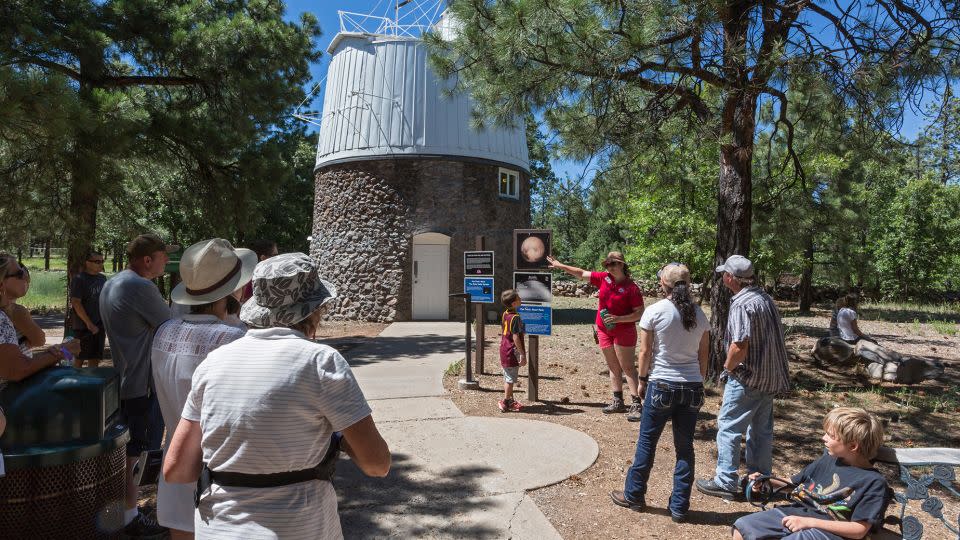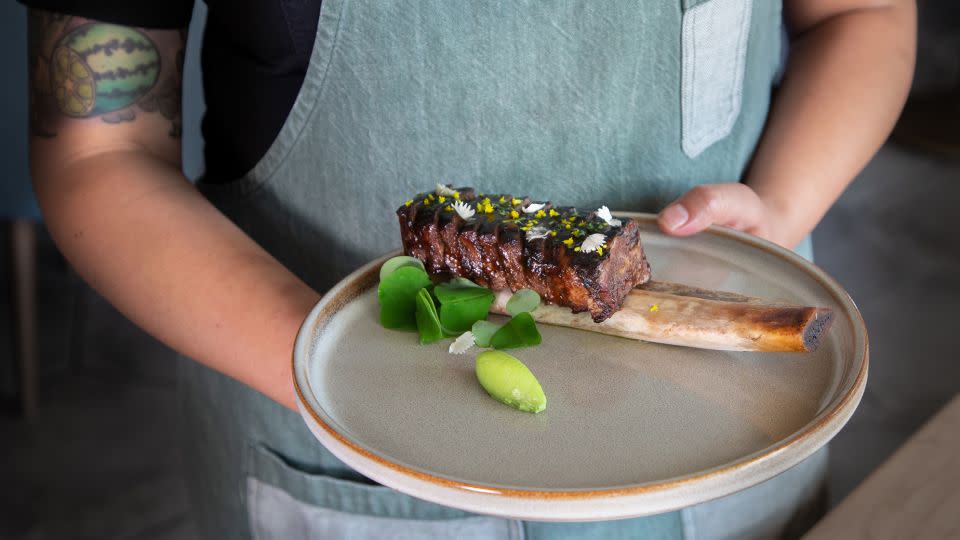Grand Canyon pit stop is now a bona fide hot spot
unknown content item
-
For years, Flagstaff was a place that you passed through on your way to the Grand Canyon or following Route 66 to the California shore. Unless you needed gas or a quick meal, there was little reason to stop.
Yet slowly but surely, the northern Arizona city has transformed into a vacation destination in its own right. Flagstaff remains a gateway to the Grand Canyon and other natural wonders. But since the turn of the century, it’s become more than just a pit stop.
Nowadays, there are multiple reasons to linger in a city surrounded by the world’s largest ponderosa pine forest at the base of the snowcapped San Francisco Peaks.
A stark contrast to the desert cities of southern Arizona, Flagstaff offers cooler temperatures, fresh mountain air and a growing reputation for outdoor recreation ranging from winter skiing to summertime hiking, biking and trail running.
The renaissance of downtown Flagstaff brought new life to its old brick buildings in the form of hip new places to eat, drink and sleep.
With Lowell Observatory in the forefront, the city has become a hub of scientific research as well as being named the world’s first official “International Dark Sky City” in 2001.
Meanwhile, Northern Arizona University upped its game in athletics and academics, bringing even more attention and visitors to a place considered a backwater for many decades.
With around 76,000 residents, Flagstaff is no longer a small town. Yet the vibe is anything but big city. Some of the first things you notice — a slower pace, the woodsy air and a star-filled night sky — are more or less absent from larger urban areas.
Spectacular skies
The university is what brought local ceramic artist Robin Cadigan to town, but she soon fell in love with Flagstaff’s wide-open spaces, active lifestyle and flourishing creative community.
“A lot of people move here because of the landscape and natural beauty, the access to trails and mountains and the Grand Canyon,” says Cadigan, who grew up in Maine.
“There’s like over 300 days of sun here a year. And it’s a wonderful place to raise a family, especially if you like to do things outdoors with your kids. I love my tree time!” she beams. (Sunny days may stack up a bit shy of 300, but not by much).
Cadigan mentions Lowell Observatory as a place she often visits with her two kids for science-based summer camps or one-off astronomy programs aimed at locals and out-of-town visitors.
In addition to tours, exhibits, stargazing and a chance to peer through historic telescopes, the observatory that discovered Pluto in 1930 is opening the new Marley Foundation Astronomy Discovery Center (ADC) this fall.
One of the most advanced astronomy centers anywhere on the planet, the ADC will feature a state-of-the-art theater with wrap-around screen and a curiosity zone for kids. It will also have the world’s first dark sky planetarium on the top floor — a roofless viewing area with theater-like seats where visitors can look straight up at the sky while an astronomer explains what they’re seeing.
That’s not Flagstaff’s only connection to outer space. Meteor Crater shows the impact of a meteorite crashing into the Earth’s surface around 50,000 years ago just east of town.

The 10-day Flagstaff Festival of Science in September often features speakers from the city’s lunar legacy, including scientists from the USGS Astrogeology Science Center, which helped design the Lunar Rover and map the surface of the moon and planets in our solar system.
Buffalo Park on the mesa behind the Astrogeology Science Center is one of the city’s best spots for stargazing and a venue for star parties organized by the Flagstaff Dark Skies Coalition.
Despite its heavenly reputation, it was things happening on the ground that really sparked Flagstaff’s emergence as a bona fide travel destination.
Downtown Flagstaff’s rebirth
Once upon a time, downtown Flagstaff was home to restaurants and bars that largely catered to locals who worked in the timber and ranching industries but not students or tourists. By the 1990s, even the cowboys and lumberjacks had stopped coming.
Fortunately, many of the antique redbrick structures were listed on the National Register of Historic Places. So they couldn’t be knocked down, and that left them ready for their transformation into today’s shops, restaurants and entertainment outlets.
Riffing off the historic buildings, new redbrick sidewalks and throwback street signs and lampposts have been installed.
In the middle of downtown, a once vacant lot has been transformed into Heritage Square, a “community living room” that hosts events in a 1,200-person capacity amphitheater and puts on exhibits on the city’s history, biology, geology and anthropology. From summer outdoor movies and concerts to the Northern Arizona Book Festival in the spring and Flagstaff Music Festival in the fall, the square hosts scores of events throughout the year.
Another anchor of Flagstaff’s revitalized downtown is the Orpheum Theatre. Opened in 1916, the stage and movie palace fell into the same disrepair as the rest of the neighborhood but was saved from demolition and revived in the early 21st century to host a broad gamut of films and live performances.
Another heirloom building, with an original 1888 pressed tin ceiling and sandstone façade, houses Babbitts Backcountry Outfitters, where anyone headed for the great outdoors around Flagstaff can buy or rent gear.
New on the downtown scene is Planet Science, which taps into the city’s astro-tourism scene with merchandise such as meteorite fragments, NASA swag and spaceship models. Vintage clothing stores, fashion boutiques and Western art galleries also populate the revitalized downtown.

A culinary shift
The local food scene has also flipped the script.
Dara Wong, the chef-owner of Shift Kitchen & Bar and Oeno Wine Lounge (and another NAU graduate), says downtown Flagstaff dining was “very steak and potatoes about 10 years ago” when Shift debuted. “I thought it was time for a little more fine dining — small plates and unique flavor combinations utilizing local products.”
Were local diners ready for such a drastic change? “Like any new business,” says Wong, “it took a little bit of time. But we definitely got some wonderful regulars right off the bat, and I would say it was right on trend.”
That trend has brought a diverse range of eateries to downtown and the Southside neighborhood on the other side of the railroad tracks. Among the most talked about are modern American restaurant Atria, FLG Terroir: Wine Bar & Bistro and Beaver Street Brewery & Whistle Stop Café. The latter is one of eight stops on the Flagstaff Brewery Trail that highlights the city’s top craft beermakers.
The outdoor scene
The city’s location in the middle of Coconino National Forest and near the base of the San Francisco Peaks means it offers outdoor adventure opportunities for all seasons and just about every level of fitness.
“It’s not uncommon to see professional runners come here to train because of the altitude and the access to different types of terrain,” says local photographer and trail runner Austin Corbett.
But you don’t have to be a professional or competitive athlete to take off down the many trails that fan out from Flagstaff.
The ever-expanding Flagstaff Urban Trails System (FUTS) stretches 56 miles (90 kilometers) through forests, fields and canyons. Hiking many of the sections of the Flagstaff Loop Trail surrounding town takes only one to two hours.
A portion of the long-distance Arizona Trail meanders through the middle of the city on its way from the Mexican border to the Grand Canyon and beyond. The three sections around Flagstaff are long (averaging around five hours to hike) but not especially challenging.
Humphreys Peak is ground zero for Flagstaff’s winter sports scene. Or more specifically the Arizona Snowbowl in Coconino National Forest on the mountain’s west side.
The ski area boasts 55 runs, three terrain parks and eight lifts including an enclosed gondola. Topping out at 11,500 feet (3,500 meters), the resort recorded 23 feet (7 meters) of snow for the 2023-24 season.
unknown content item
-
‘Living in heaven’
Looming just north of Flagstaff, Humphreys is the highest of a handful of summits that comprise San Francisco Mountain — more commonly called San Francisco Peaks. In addition to its scenic and recreational roles, the mountain is revered by Native American groups including the Navajo, Hopi, Zuni and Apache peoples of northern Arizona.
“Growing up in this area, the San Francisco Peaks — Dookʼoʼoosłííd as we call it in Navajo — is one of four sacred mountains for Navajo people. And being here, in this area, at the base of this mountain, is literally living in heaven,” says Darrell R. Marks, a community activist, educator and Native American mentor at two Flagstaff high schools.
Marks, winner of a 2021 JFK Profile in Courage Award, worked with his teenage sons to petition the state government to change the name of Agassiz Peak to Öo’mawki, its Hopi name — a change that was approved by Arizona officials last year. As a member of the city’s Indigenous Commission, Marks is advocating the development of cultural centers to host “public events that celebrate indigenous culture, identity, voice, presence and share those narratives of just how important this area is to us.”
For the time being, he says the best way for visitors to tap into local Native American culture is attending the Flagstaff High School Powwow in May, which features more than 250 dancers and drummers or browsing the many Native American exhibits at the city’s Museum of Northern Arizona.
“Before curating and putting exhibits together,” says Marks, the museum “consults with the tribes, brings them into the space and has them help organize what needs to be present. They’ve done a really good job.”
Just outside Flagstaff are two significant Ancestral Puebloan sites — the 12th-13th century cliff dwellings of Walnut Canyon National Monument and the 12th century pueblos of Wupatki National Monument.
“There’s so much to celebrate in this space,” says Marks of his hometown.
“The variation is one of the things that blows my mind. One side of town could be snowing, and the other side could be sunny. And you have to drive a short distance to go from forests to the Painted Desert to grasslands with pronghorn antelope and Oak Creek Canyon. It’s amazing how the landscape changes in just a couple of miles.”
Next town: Macon, Georgia is No. 7
Find out how this Southern town went from “ghost town” to “popping” destination.
Author of the National Geographic Book “100 Cities, 5,000 Ideas,” Joe Yogerst has been visiting family and friends in Northern Arizona since he was a little kid.
For more CNN news and newsletters create an account at CNN.com


